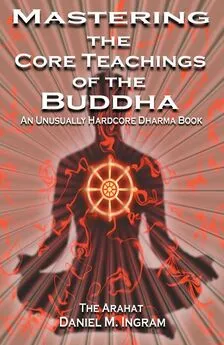Daniel Ingram - Mastering the Core Teachings of Buddha - An Unusually Hardcore Dharma Book
- Название:Mastering the Core Teachings of Buddha - An Unusually Hardcore Dharma Book
- Автор:
- Жанр:
- Издательство:Aeon Books
- Год:2009
- ISBN:9781904658405
- Рейтинг:
- Избранное:Добавить в избранное
-
Отзывы:
-
Ваша оценка:
Daniel Ingram - Mastering the Core Teachings of Buddha - An Unusually Hardcore Dharma Book краткое содержание
Mastering the Core Teachings of Buddha - An Unusually Hardcore Dharma Book - читать онлайн бесплатно полную версию (весь текст целиком)
Интервал:
Закладка:
There are faster and slower vibrations that may show up, some very fast (maybe up to forty times per second) and some very slow (that are actually made up of faster vibrations), but let's just say that one to ten times per second can sometimes be a useful guideline in the beginning.
Once you get the hang of it, the faster and slower vibrations are no big deal. Alternately, depending on how you practice, conceiving of this as like a shower of raindrops, a pointillist painting in motion, or 3D TV
snow might help. Reality is obviously quite rich and complex, and thus the frequencies of the pulses of reality can be somewhat chaotic, but they actually tend to be more regular than you might expect. Also, there are not really any “magic frequencies.” Whatever frequency or pulse or whatever you are experiencing at that moment is the truth of that moment! However, in the beginning you should go for faster vibrations over slower ones and then try for wider ones over those that are narrower.
Don't worry if things look or feel solid sometimes. Just be with the solidity clearly and precisely, but not too tightly, and it can start to show its impermanence. Be aware of each exact moment in which you experience solidity and its beginning and ending. Remember that each experience of solidity is a separate, impermanent sensation! Many people begin practicing and really want to solidify something like the breath so that they can actually pay attention to it. They become frustrated when they have a hard time finding the breath or their body or whatever. The reason they can’t find it is not because they are a bad meditator but because they are having direct insight into how things actually are! Unfortunately, their theory of what is supposed to happen 20
The Three Characteristics
involves really perceiving something solid and stable, so they get very frustrated. You should now be able to avoid a lot of that frustration and begin to appreciate why knowing some theory is important.
It is also worth noting here that the frequency or rate of these vibrations may change often, either getting faster or slower, and that it is really worth trying to see clearly the beginning and ending of each vibration or pulse of reality. These are actually at least two different sensations! It is also useful to check out exactly what happens at the bottom, middle, and top of the breath if you are using the breath as an object, and to examine if the frequency stays stable or changes in each phase of the breath. Never assume that what you have understood is the final answer! Be alert! Explore carefully and precisely with openness and acceptance! This is the door to understanding.
One last thing about vibrations: looking into vibrations can be a lot like any other sport. It can be thought of the way we might think of surfing or playing tennis, and this sort of game-like attitude can actually help a lot. We're “out to bust some vibrations!” as a friend of mine enthusiastically put it. You don't know quite what the next return or wave is going to be like, so pay attention, keep the mind on the pulse of the sensations of your world just as you would on the wave or ball, and keep playing!
I highly recommend this sort of speed in practice not only because that is how fast we have to perceive reality in order to awaken, but also because trying to experience one to ten sensations per second is challenging and engaging. Because it is challenging and engaging, we will be less prone to getting lost in thoughts rather than doing insight practices. Our minds have the power to perceive things extremely quickly, and we actually use this power all the time to do such things as read this book. You can probably read many words per second. If you can do this, you can certainly do insight practices.
If you can perceive one sensation per second, try for two. If you can perceive two unique sensations per second, try to perceive four. Keep increasing your perceptual threshold in this way until the illusion of continuity that binds you on the wheel of suffering shatters. In short, when doing insight practices, constantly work to perceive sensations arise and pass as quickly and accurately as you possibly can. With the 21
The Three Characteristics
spirit of a racecar driver who is constantly aware of how fast the car can go and still stay on the track, you are strongly advised to stay on the cutting edge of your ability to see the impermanence of sensations quickly and accurately.
I will relate four of the many little exercises that I sometimes do that I have found useful for jump-starting and developing insight into impermanence. They will demonstrate how we can be creative in exploring our reality precisely but hopefully they will not be thought of in some sort of dogmatic way. These objects and postures are not that important, but understanding impermanence directly is.
In one of these exercises, I sit quietly in a quiet place, close my eyes, put one hand on each knee, and concentrate just on my two index fingers. Basic dharma theory tells me that it is definitely not possible to perceive both fingers simultaneously, so with this knowledge I try to see in each instant which one of the two finger’s physical sensations are being perceived. Once the mind has speeded up a bit and yet become more stable, I try to perceive the arising and passing of each of these sensations. I may do this for half an hour or an hour, just staying with the sensations in my two fingers and perceiving when each sensation is and isn’t there. This might sound like a lot of work, and it definitely can be until the mind settles into it. It really requires the concentration of a fast sport like table tennis. This is such an engaging exercise and requires such precision that it is easy not to be lost in thought if I am really applying myself. I have found this to be a very useful practice for developing concentration and debunking the illusion of continuity. You can pick any two aspects of your experience for this exercise, be they physical or mental. I generally use my fingers only because through experimentation I have found that it is easy for me to perceive the sensations that make them up.
In another related exercise, I do the same sort of thing, sitting quietly in a quiet place with my eyes closed, but instead I concentrate on the sensations of the front and back of my head. With the knowledge that the illusion of a separate perceiver is partially supported by one impermanent sensation incorrectly seeming to perceive another impermanent sensation which it follows, such as the sensations in the back of the head incorrectly seeming to perceive the sensations of the 22
The Three Characteristics
front of the head which they follow, I try to be really clear about these sensations and when they are and aren’t there. I try to be clear if the sensations in the head are from the front or the back of the head in each instant, and then try to experience clearly the beginning and ending of each individual sensation.
This practice also requires a table tennis-like precision. Half an hour to an hour of this can be quite a workout until the mind speeds up and becomes more stable, but this sort of effort pays off. When I am engaged with this practice, there is little room to be lost in thought. I have also found this a very useful practice for developing concentration and debunking the illusion of continuity and the illusion of a separate self (more on that later).
In another exercise, which is quite common to many meditation traditions, I sit quietly in a quiet place, close my eyes, and concentrate on the breath. More than just concentrating on it, I know that the sensations that make up the concept “breath” are each impermanent, lasting only an instant. With this knowledge, I try to see how many individual times in each part of the breath I can perceive the sensations that make up the breath. During the in-breath I try to experience it as many times as possible, and try to be quite precise about exactly when the in-breath begins and ends.
More than this, I try to perceive exactly and precisely when each sensation of motion or physicality of the breath arises and passes. I then do the same for the out-breath, paying particular attention to the exact end of the out-breath and then the beginning of the new in-breath. I don’t worry about how I am breathing because it is not the quality of the breath which I am concerned with or even what the sensations are, but the ultimate nature of these sensations: their impermanence, their arising and passing away. When I am really engaged with bending the mind to this exercise, there is little room to be lost in thought. I have found this to be a very useful practice for developing concentration and penetrating the illusion of continuity.
In the last exercise, I take on the thoughts directly. I know that the sensations that make up thoughts can reveal the truth of the Three Characteristics to me, so I have no fear of them; instead I regard them as more glorious opportunities for insight. Again, sitting quietly in a 23
The Three Characteristics
quiet place with my eyes closed, I turn the mind to the thought stream.
However, rather than paying attention to the content like I usually do, I pay attention to the ultimate nature of the numerous sensations that make up thoughts: impermanence. I may even make the thoughts in my head more and more intense just to get a good look at them.
It is absolutely essential to try to figure out how you experience thoughts, otherwise you will simply flounder in content. What do thoughts feel like? Where to they occur? How big are they? What do they look like, smell like, taste like, sound like? How long do they last?
Where are their edges? Only take on this practice if you are willing to try to work on this level, the level that tries to figure out what thoughts actually are rather than what they mean or imply.
If my thoughts are somewhat auditory, I begin by trying to perceive each syllable of the current thought and then each syllable’s beginning and ending. If they are somewhat visual, I try to perceive every instant in which a mental image presents itself. If they seem somewhat physical, such as the memory of a movement or feeling, I try to perceive exactly how long each little sensation of this memory lasts. This sort of investigation can actually be fairly easy to do and yet is quite powerful.
Things can also get a bit odd quickly when doing this sort of practice, but I don’t worry about that. Sometimes thoughts can begin to sound like the auditory strobing section of the song “Crimson and Clover,”
where it sounds like they are standing at a spinning microphone.
Sometimes the images in our head can begin to flash and flicker.
Sometimes our very sense of attention can begin to strobe. This is the point! The sensations that imply a mind and mental processes are discontinuous, impermanent.
Again, this practice requires steadiness and determination, as well as precision. When I am really engaged with this, there is no time to be lost in the content of the thoughts, as I am trying too hard to be clear about the beginning and ending of each little flicker, squawk and pulse which makes up thought. This can be an especially fun practice when difficult thoughts are distracting me from a physical sensation. I can turn on them, break them down into meaningless little blips, little vibrations of suchness, and then they don’t have the power to cause me any trouble. They just scatter like confetti. They are seen as they are: small, 24
The Three Characteristics
quick and harmless. They have a message to convey, but then they are gone.
When I am done with this exercise, I return to physical objects and their arising and passing. However, I have found taking on the sensations that make up thoughts to be another very useful exercise for developing concentration and penetrating the illusion of continuity. It doesn’t matter if they are “good thoughts” or “bad thoughts,” as all mental sensations are also dripping with ultimate truth that is just waiting to be discovered, and thus I can proceed in my investigation with confidence regardless of what arises. Whether our illusions are penetrated using physical sensations or mental sensations is actually completely irrelevant.
Читать дальшеИнтервал:
Закладка:





![Дженнифер Гюнтер - The vagina book. Главная книга для тех, у кого есть этот орган [litres]](/books/1061538/dzhennifer-gyunter-the-vagina-book-glavnaya-kniga-dl.webp)




